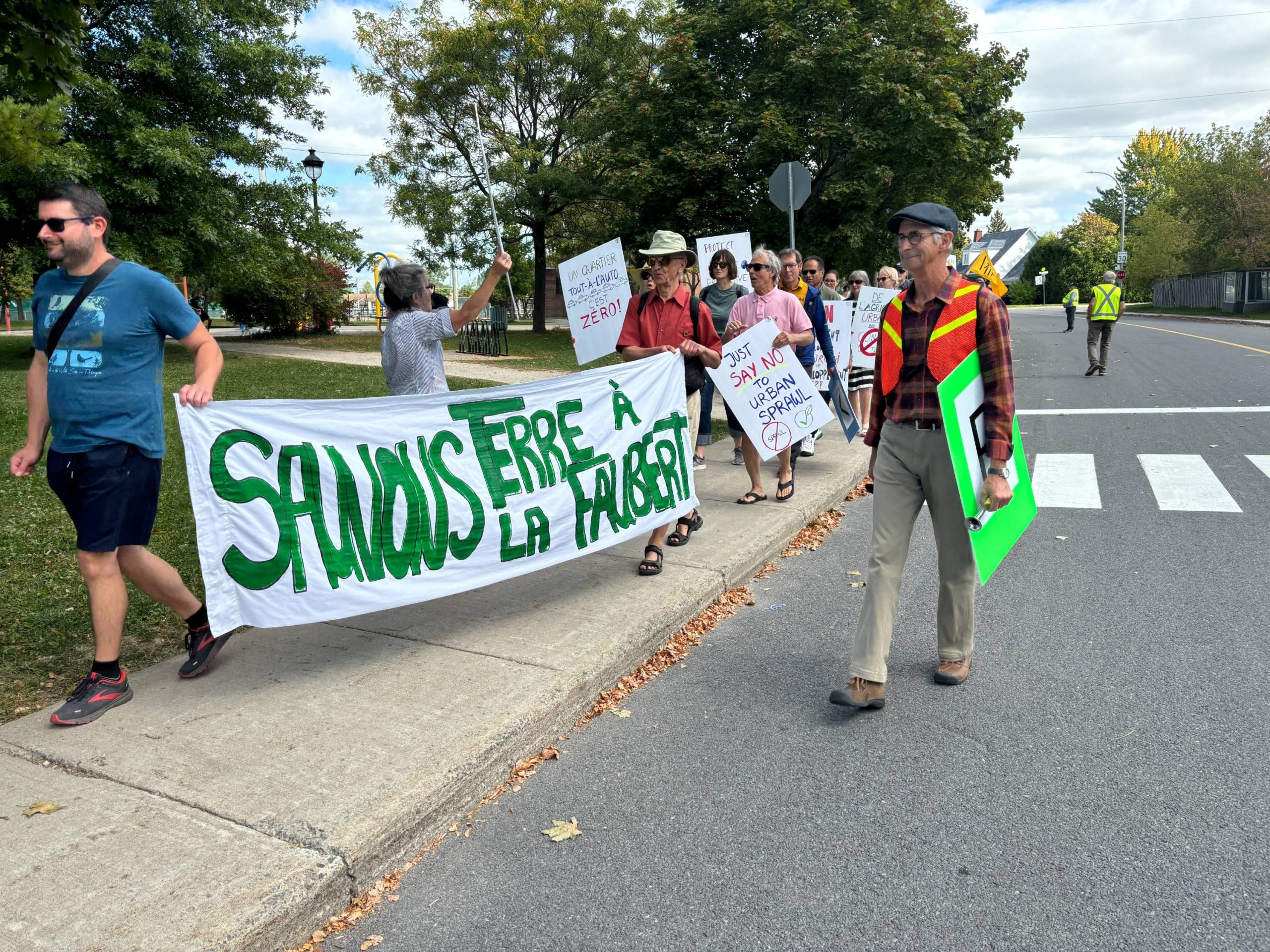A demonstration against the development of Terre Faubert

Four environmental groups joined forces to organize the demonstration. (Photo:Le Soleil – Valérie Lessard)
On September 22, some forty people, placards in hand, marched through the streets of Châteauguay, protesting the possible future development of Terre Faubert. They called on the city to put the project on hold and, ultimately, to protect this wooded area along Highway 30.
Translation Amanda Bennett
Four environmental groups - SOS Fernand-Séguin, Sauvons la terre à Faubert, Boisés et écologie-Châteauguay and À Châteauguay, quelle ville voulons-nous? joined forces to organize the demonstration, which ended in front of the Terre Faubert buildings behind the Piscine René-Pitre store. The buildings were demolished the day after the event, the city having given its authorization a few weeks earlier.
A time-out to reflect
“We're asking the city to pause, that is, to wait and reflect before acting,” said Chantal Payant, a member of the Boisé et écologie-Châteauguay group, just before the start of the march. She pointed out that the city is currently working on a special urban plan to control development possibilities on Terre Faubert, that it has also initiated a comprehensive review of its urban plan, that it is beginning its ecological transition plan and is also analyzing the state of its underground infrastructures.
“So we're saying to the City: before you develop new neighborhoods, can you please just do your planning correctly [as required] and you'll realize, that, perhaps, you don't need to develop in natural environments,” explained Ms. Payant.
The preliminary draft of the special urban plan presented by the city in June calls for the construction of buildings ranging from two to eight storeys, for an approximate number of 1,500 to 2,000 housing units. The city would require the retention of a minimum 30% wooded area.
Densification elsewhere
Guy Turcotte, a member of SOS Fernand-Séguin, is concerned about this residential neighborhood project, which he describes as “all about the car” since it is far from services. ” You're going to need a car if you want to do anything. If we put 5,000 to 7,000 people [in this neighborhood], that's 3,500 to 5,000 cars on the road every day to go to the grocery store, school and daycare. It's crazy,” he pointed out.
Chateauguay resident Florian Rouaud, a member of the Sauvons la terre group in Faubert, is involved in the cause even though he doesn't live near the project site. “I'm concerned by the project because it's in my town, and protecting the natural environment is one of my values,” he explained.
“We're not against building housing, we're aware of the housing crisis, but can we rethink urban planning policies to avoid urban sprawl?” The Chateauguay resident makes reference to his native France, where the downtown areas of many cities have been densified. In his view, boulevard D'Anjou would be a better place to build eight-storey buildings than on the side of a highway. “We can revitalize the boulevard by having shops below and housing above,” he illustrates.
For Châteauguay mayor Eric Allard, Terre Faubert can be an example of how natural environments and housing for those who need it can coexist. The city's website states that the objective of the plan particulier d'urbanisme, PPU, “is to ensure that development is integrated into the existing environment, that natural environments are protected, that green and wooded spaces are preserved, that parks are created, that automobile, active and public transportation is organized, and that a complete quality living environment is created that meets the needs of its residents”.
In its preliminary PPU, the city proposes to “mitigate highway noise by building higher along the highway”. Opponents of the project consider this to be contrary to the recommendations of the Direction de santé publique de la Montérégie. In an intervention sheet published in January 2024, the Public Health Department states that “screen buildings (e.g., rows of commercial, office and industrial buildings) are the most effective measures” in terms of soundproofing. However, the PPU only mentions residential construction along the expressway.
Santé publique de la Montérégie indicated that “living near a road with high traffic flow can result in a significant health burden, and is notably associated with asthma in children and respiratory or cardiovascular diseases in the elderly”.
Next steps
A public meeting on the Terre Faubert PPU will be held on October 24 at 7 p.m., in the Jean-Pierre-Houde room of the Centre culturel Vanier. The draft by-law, which will define the land's development possibilities, will be presented and the public will have an opportunity to express their views.
The City had also been seeking comments from citizens for a month this summer, following the presentation of the preliminary draft of the PPU. It received 35 suggestions and comments through this process. A summary of these will be presented at the “public consultation session” in October.